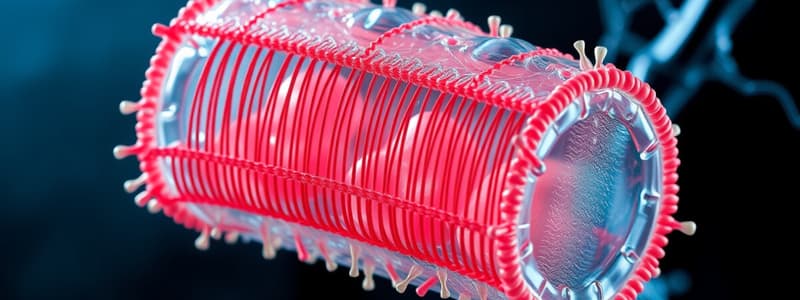Podcast
Questions and Answers
What is the function of cholesterol in the plasma membrane?
What is the function of cholesterol in the plasma membrane?
- Assists in cell division.
- Provides energy to the cell.
- Helps to stabilize the structure of the plasma membrane. (correct)
- Acts as a barrier to toxins.
What are phospholipids recognized by?
What are phospholipids recognized by?
The presence of a head and two tails.
What is a glycoprotein composed of?
What is a glycoprotein composed of?
Both a carbohydrate and a protein.
What is diffusion across a biological membrane called?
What is diffusion across a biological membrane called?
When molecules move down their concentration gradient, they move from where they are _____ to where they are _____.
When molecules move down their concentration gradient, they move from where they are _____ to where they are _____.
Facilitated diffusion is a type of what?
Facilitated diffusion is a type of what?
What name is given to the process by which water crosses a selectively permeable membrane?
What name is given to the process by which water crosses a selectively permeable membrane?
What does hypertonic mean?
What does hypertonic mean?
You know that this cell is in a(n) _____ solution because the cell _____.
You know that this cell is in a(n) _____ solution because the cell _____.
You know that this cell is in a(n) _____ solution because it _____.
You know that this cell is in a(n) _____ solution because it _____.
Endocytosis moves materials _____ a cell via _____.
Endocytosis moves materials _____ a cell via _____.
You can recognize the process of pinocytosis when?
You can recognize the process of pinocytosis when?
A white blood cell engulfing a bacterium is an example of what?
A white blood cell engulfing a bacterium is an example of what?
Which cell junction forms a barrier to the passage of materials?
Which cell junction forms a barrier to the passage of materials?
What is the primary role of desmosomes?
What is the primary role of desmosomes?
What aid in the coordination of the activities of adjacent animal cells?
What aid in the coordination of the activities of adjacent animal cells?
Why can't cells get as large as golf balls?
Why can't cells get as large as golf balls?
Which substance will diffuse across the membrane fastest if there are no membrane proteins?
Which substance will diffuse across the membrane fastest if there are no membrane proteins?
Which direction is water most likely to move if there is a membrane or concentration difference between two regions?
Which direction is water most likely to move if there is a membrane or concentration difference between two regions?
What simple property causes molecules to diffuse from high concentration toward a lower concentration?
What simple property causes molecules to diffuse from high concentration toward a lower concentration?
What is the word for membrane proteins that have carbohydrates attached to them?
What is the word for membrane proteins that have carbohydrates attached to them?
Which membrane proteins increase the rate of chemical reactions?
Which membrane proteins increase the rate of chemical reactions?
Desmosomes are similar to what structure?
Desmosomes are similar to what structure?
Which of the following is most like a gap junction?
Which of the following is most like a gap junction?
Flashcards are hidden until you start studying
Study Notes
Cholesterol and Membrane Structure
- Cholesterol stabilizes the plasma membrane by maintaining its structure.
Phospholipids
- Phospholipids characterized by a hydrophilic head and two hydrophobic tails play a crucial role in forming cell membranes.
Glycoproteins
- Glycoproteins are molecules composed of both carbohydrates and proteins, important for cell recognition and signaling.
Transport Mechanisms
- Passive Transport involves diffusion across biological membranes without energy expenditure.
- Molecules move from areas of higher concentration to areas of lower concentration during diffusion.
- Facilitated diffusion is a passive transport method that requires specific membrane proteins but no energy input.
Osmosis
- Osmosis is the process by which water crosses selectively permeable membranes.
Solutions and Cell Behavior
- Hypertonic solutions have a higher concentration of solute outside the cell, causing water to move out, leading to cell shrinkage.
- Hypotonic solutions lead to water influx, causing cells to swell.
Endocytosis
- Endocytosis transports materials into the cell through membranous vesicles.
- Pinocytosis refers to the process where a cell engulfs extracellular fluid.
- Phagocytosis occurs when a white blood cell engulfs a bacterium, demonstrating the cell's ability to consume large particles.
Cell Junctions
- Tight junctions form barriers that prevent material passage between cells.
- Desmosomes anchor cells together for structural support.
- Gap junctions facilitate communication and coordinate activities among adjacent animal cells.
Cell Size Limitations
- Cells cannot grow as large as golf balls due to insufficient surface area for material exchange.
Diffusion of Molecules
- Oxygen diffuses fastest across membranes when no membrane proteins are present due to its small size.
- Water typically moves from a hypotonic region (low solute) to a hypertonic region (high solute).
Molecular Behavior
- Molecules diffuse from high to low concentration driven by their random motion.
Membrane Proteins
- Glycoproteins have carbohydrates attached, influencing cell interactions.
- Enzymatic proteins facilitate and increase the rate of chemical reactions within the cell.
Structural Support
- Desmosomes function similarly to the cytoskeleton by providing structural integrity to cells.
- A nuclear pore is analogously comparable to a gap junction, allowing communication between cellular compartments.
Studying That Suits You
Use AI to generate personalized quizzes and flashcards to suit your learning preferences.




